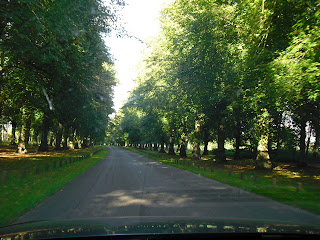Lake District
We spent the weekend in the Lake District national park in
the village of Keswick on Lake Derwentwater.
We stayed in the Badger Wood Bed and Breakfast because it catered to
special diets. The breakfasts were wonderful and filling.
The highest mountains in the area were around 3500 ft. Which is much higher than we were told was
England’s highest peak. It was a busy
market town on Saturday with a lot of tourists as it was the last weekend
before school starts again. There is a
small local theater that shows a different play every night so we went to both
the Friday and Saturday plays.
 |
| Walla Crag destination of our hike. |
Since walking (hiking) is the English past time we, after
talking with our host, set out on a medium difficult 4 mile hike. We started by
taking the lake taxi counterclockwise around to the 6th stop. The
taxi goes a different direction each half hour and takes an hour to
circumnavigate the lake.
 |
| Taxi boat at dock |
Our goal was to get off at Ashness Gate Pier, walk to
Ashness Bridge, take a trail from there and hike around Walla Crag, down Cat
Ghyl trail and back to Keswick.
 |
| Ashness Bridge |
We got off at Ashness Gate pier and proceeded uphill toward
Ashness Bridge. Since this bridge is the most photographed bridge in the Lake
District, we were expecting something outstanding or breathtaking. We hiked to a stream with a small bridge
crossing it and assuming this was not the bridge hiked on.
After two miles up hill and reaching a sign
announcing the summit of the road and no bridge insight, we wondered where to
go. John hiked about a half mile ahead while I enjoyed the woods from the summit of the road.
 |
| Forest from road summit |
He didn’t see any sign of a bridge and as we
were hiking away from Walla Crag we decided to forget the bridge and return to
hike around the crag.
On the way back we did stop to enjoy a viewpoint looking out
over the lake. Asking some of the people there where the bridge was, and where
we were, we got answers of “they didn’t know” to “we passed the bridge about a
mile and a half back.” It was the small bridge we had crossed. We hiked back to that bridge and asking again
where the trail was to Walla Crag? Our
guide book kept telling us to go through a gate to the bridge then retrace our
step to the gate return through it and turn up hill. We had never seen any gates to go
through. We were shown the trail that cannot
be seen as you approach from downhill.
We started up hill and the track wasn’t bad for a while then
it became a sometimes dry waterfall, sometimes wet, often muddy, big steps even
for my long legs, and very steep in parts.
 |
| View of trail, fern field, bridge in background |
 |
| Trail with Stream |
After the first section it wasn’t as
steep but the water and mud stayed. I
did notice people taking a more gradual path down. I wish we had found that for
coming up.
The view was great and as we got to the top of the ridge the
sun came out. The wind was blowing so it
didn’t get hot. The higher hills were
covered with ferns and blooming heather.
Above us was Falcon Crag with birds soaring around it. Of course all
around us were sheep.
 |
| Falcon Crag heather in bloom |
The trails were determined by where others had walked or
where water had washed away the top soil.
The ground was covered by soil, duff, moss, heather and ferns. Water ran out of the ground from under this
top mat and down the path or in streams down the hill. We assumed the water
would be crystal clear, but it was brown in the pools where it gathered
probably from the rotting matter, marsh or bog, through which it flowed.
 |
Water running from under peat
|
We hiked the ridge and then wandered through the marsh land
behind the crag. We followed the trodden
path down the north east side, by two camp grounds and back into the city. The path down the hill was steep and grass
covered.
 |
| Looking up hill we walked down |
 |
| Path we still had to walk down |
Had it been wet we would have
slid down the hill. If you have ever
skied at Bachelor it was like walking down Thunderbird. We never saw the route that went directly
back to the city, so at this end we probably added another 2 to 3 miles to the
walk.


















.JPG)















.JPG)





